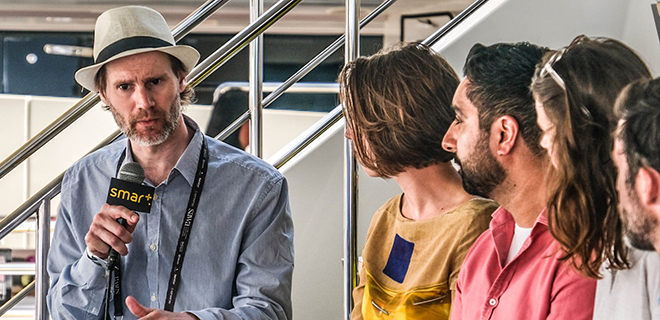
I wouldn’t be surprised if you attributed my recent silence to nursing a three-week hangover after Cannes Lions 2019. Yes, people tend to think of the festival as a refuge for advertising binge-drinking—and I won’t deny that copious amounts of alcohol found their way down my throat—but I’m always exhausted after the festival by the sheer amount of information I consume… Processing it all is another ordeal entirely.
Holy hell, this Cannes Lions was an insightful week. It’s been damn hard going through my notes and live-tweeting to wittle down THE TOP takeaways and discussions. I had to dedicate at least a thousand words to digital-linear convergence and addressable, and I find myself full of ideas for the August 2019 Publisher Forum Vancouver agenda.
However, I thought I’d share real quick some of the biggest brand-related trends I came across. More hot takes coming related to blockchain, programmatic guaranteed, and more!
Also, a word of advice—when on yachts, keep watch for rogue saxophonists.
We’ve got a rogue saxophonist at 9 o’clock #CannesLions2019 pic.twitter.com/h4qmGUmt3n
— Gavin Dunaway (@AdMonsterGavin) June 19, 2019
The Beauty of Brand Programmatic In-Housing
Several years ago during isocket presentations, founder John Ramey would show a picture of a storefront simply overflowing in sausages. The takeaway: brands don’t care how the sausage is made when it comes to media buying and, in particular, programmatic.
Brands’ lack of interest in programmatic has been a giant obstacle for the development of the space, and during a panel on creativity in the programmatic space hosted on the Smart AdServer yacht, I found myself expressing relief that the end advertisers have come to the table. Arguably, a lot of the advances in programmatic we were discussing on that panel will only come to fruition thanks to brand involvement.
Agencies are actually happy to work with programmatic-educated brands because they offer greater direction and understanding of the space, which ultimately drives better programmatic relationships between agencies and publishers. It’s exciting to see how greater participation from brands will drive the development of the space—this seems to be a key component as we enter a new age of ad tech.
Brand In-Housing… of Creative
Oh, but brands aren’t just bulking up on programmatic assets—bringing creative control in-house was a topic of wide discussion throughout Cannes Lions. One panel featuring Uber, Grey London, and Publicis Emil was billed as a battle between in-house creatives versus agencies, and though there were some pointed jabs, it became clear early on the ideal solution is creatives entrenched in the brand collaborating with agency representatives. Sounds a lot like programmatic in-housing, no?
Oh my—this #CannesLions2019 debate on creative in-housing is getting fiery. “54% of you are wrong.” pic.twitter.com/jUc8kayxN1
— AdMonsters (@AdMonsters) June 20, 2019
In general, the creative conversation at Cannes seemed to be about brands and agencies coming clean with each other. Brands acknowledged they’ve been too hands-off (and procurement-driven) with their marketing initiatives, haphazardly ordering reviews and switching agencies instead of accepting responsibilities. Agencies (creative and media alike) admitted that they haven’t fulfilled brand desires, and they need to modify business practices (e.g., embrace project-based pricing) to better meet client needs.
Creatives: don’t outsource your thinking and data to the media planners and data scientists. It’s essential to your job. #CannesLions2019
— Gavin Dunaway (@AdMonsterGavin) June 20, 2019
Social Responsibility
Creatives aren’t going gaga over cool technology like augmented reality at the moment—social responsibility and awareness campaigns are all the rage, particularly after the perceived success of Nike’s campaign with Colin Kaepernick and Gillete’s “Better Man” spots. It’s not just that these campaigns are well-received—many brands are looking for positive affiliations and social impact as charitable contributions increasingly are seen serving as tax write-offs.
Interestingly, the in-housing creative panel mentioned above highlighted just how easily such campaigns can go astray—the biggest failure of an in-house agency is the infamous Pepsi ad with Kendall Jenner that tried to co-opt recent protests.
The key (and challenge) is relevance—finding an issue where it feels appropriate for the appropriate for the brand to weigh in. Nike and Kaepernick have the obvious sport connection, but Gillette and positive male behavior isn’t quite so upfront. Risks can be rewarding, but staying genuine is essential: a coal company advocating for climate change research rings hollow. For a recent example, plenty of brands enthusiastically advocated their Pride bonafides while activists pointed out corporate donations to anti-LGBTQ politicians and groups.
But why should social responsibility fall completely into the creative bucket? Media can do its part as well. On the creativity in programmatic panel I moderated, Good-Loop Founder and CEO Amy Williams explained how the company offers programmatic video that “rewards” opt-in viewing by donating half of the advertiser’s spend to a relevant charity.
‘What if every time someone engages with your ad, they could do a little bit of good in the world?’ Our founder @ala_swimmily discussing the inspiration behind Good-Loop, on the @SmartAdServerEN panel at #CannesLions w. @AdMonsterGavin @cadielisejones @WeatherBug & @seedtag pic.twitter.com/L9ZjqkVgj6
— Good-Loop (@GoodLoopHQ) June 23, 2019
Kristin Lemkau Is an Oracle
I strongly suggest you read all the way through this thread—few brand marketing people seem on top of advertising technology quite like JPMorgan Chase CMO Kristin Lemkau.
If you can’t put your whole media tech stack on one page and easily understand/explain it, you have the wrong media stack. @KLemkau #CannesLions2019
— AdMonsters (@AdMonsters) June 17, 2019